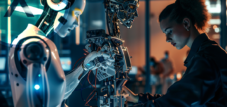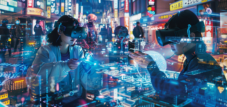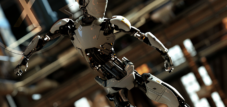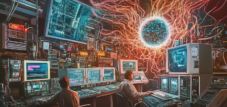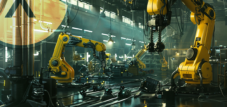Published on: April 20, 2025 / update from: April 20, 2025 - Author: Konrad Wolfenstein

From the past to the future: How to take the toy robot of the 1980s the modern robotics - picture: Xpert.digital
Inspiration through technology: Toy robot as pioneer of innovations
From the children's room to the laboratory: the surprising story of robotics
Robotics have undergone remarkable development in recent decades-from simple toys from the 80s to highly complex AI-controlled systems. It is particularly fascinating how toy robots such as the Armatron not only inspired a generation of children, but also inspired future engineers and developers. These early encounters with robot technology laid the foundation for innovations that shape the industry today. The way from simple mechanical toys to modern collaborative robots shows an example of how technological development is based on previous ideas and progress is made through continuous further development.
Suitable for:
- Virtual Reality: My first Metaverse in 1972 with the View-Master and further development over the 90s until today (Konrad Wolfenstein)
The toy robots of the 1980s: technical miracles of their time
The 1980s were a heyday for robot toys that gave children initial insights into the then futuristic world of robotics. One of the best -known copies was the Armatron of Radio Shack (also sold under the Tandy brand), a robot arm with six axes (degrees of freedom), which was operated electromechanically with only one engine. This technically impressive construction used a sophisticated mechanical gear that enabled different movements, although only one engine was installed. The Armatron was controlled by two mechanical joysticks and represented a remarkable combination of entertainment and technology for that time.
Other popular robot toys of this era were the talk-o-tron, a remote-controlled robot that impressed with simple voice functions, as well as the Emiglio, a multifunctional toy robot that could even act as a serving aid. These toys were often offered for remarkable sums between 65 and 395 euros, which underlines their status as a coveted collector's items. Especially the Japanese robot toys such as “Diaclone” and “Micro Change”, which were later marketed under the name “Transformers”, gained worldwide fame. The idea of robots that could turn into vehicles began in 1983 at a toy fair in Japan and quickly developed into a global phenomenon.
The technical complexity of these toys was remarkable for the time and often represented the first contact of many children with the basic principles of robotics, such as freedom degrees, electromechanical control and the basics of programming.
The Armatron: source of inspiration for a generation of robot engineers
It is particularly interesting how the Armatron inspired a whole generation of later robot engineers. Adam BLL, a mechanical engineer who worked for 15 years at Boston Dynamics on famous robot projects such as Petman, Atlas and the dog -like quadruped spot, names the Armatron as an important influence in his childhood. He remembers how he tried the robot arm in Radio Shack branches: "I knew it was a toy, but it felt like a real robot." This early fascination led him to collect coins to buy soldering iron and soldering on Radio Shack - a first step into his later career as an engineer.
Eric Paulos, professor of electrical engineering and computer science at the University of Berkeley, also reports of his enthusiasm for the Armatron: “It was an endless adventure to lift and move things, and just watch how it works. It was fascinating. I had the feeling that I really had my own little robot. Today Paulos builds and teaches students how to construct robots, and sees direct parallels between the challenges with which he was confronted as a child while playing with the Armatron, and the problems on which researchers still work today.
Also noteworthy is an anecdote from the school context: At the commercial technical schools in Offenbach, students used a SEL Z80 trainer as part of the electrical engineering school to develop a Z80-based control for a small 6-axis robot arm. This self -made robot was even used to distribute certificates at the Abitur eggs - an early practical use of robotics in the field of education.
The development of robotics since the 1980s
In parallel to the world of toy robots, professional robotics developed rapidly in the 1980s. An important progress was the development of robots that could perceive their surroundings and adapt to it, as well as the use of artificial intelligence in order to solve problems independently and make decisions autonomously. The availability of more powerful computer processors and improvements in sensors contributed significantly to the fact that robots could be used more versatile and more complex tasks were able to perform.
An important milestone was the presentation of the first humanoid robot EO (Honda's Experimental Omron) by the Japanese automobile manufacturer Honda in 1986. This 1.30 meter robot was able to maintain and go and was equipped with sensors that made it possible for him to perceive his surroundings. Equipped with computer-controlled joints and an artificial muscle structure, the Honda-EO was able to carry out more natural movements than other humanoid robots of this time and laid the foundation for later developments such as the Asimo robot.
In the 1960s to 1980s, the transition from robots from research laboratories to industrial environments took place. The technical innovations of this time, in particular through the first commercial successes of the Unimate robot, enabled new applications in production. General Motors was one of the first companies to integrate these machines into their production lines, and thanks to progress in microelectronics and computer science, more advanced robots were developed in the 1970s and 1980s, while production costs dropped.
Modern robotics: From playful beginnings to AI-controlled systems
Today's robotics have far away from its beginnings, but still carries the DNA concepts in the past. Modern trends in robotics include the simplification of operation and programming, so that non-experts can also use robots. Even collaborating robots, which can be built up in a few minutes and can be ready for use today, follow the basic principle of accessibility, which also focused on toy robots such as the Armatron.
Another important trend is the use of virtual simulation and digital twins. This enables manufacturers, robot movements and the effects of changes to parameters before they are implemented. This technology is increasingly linked to AI algorithms, which significantly expands the possibilities.
Modular robots represent another innovation. These special robots consist of various interchangeable modules that can be adapted or replaced depending on the requirements of production, which significantly increases flexibility and adaptability. Thanks to the possibility of changing modules as required or integrating new modules, modular robots can take on various tasks and adapt to changing requirements in production.
Artificial intelligence plays an ever greater role in modern robotics. The main purpose of the AI use is to better master fluctuations and unpredictable in the area-be it in real time or offline. Through algorithms of the AI, robots are able to learn independently and can therefore do tasks better and better.
Fabian Westerheide, a AI expert, emphasizes that the image of robotics has changed fundamentally in recent years. While robots used to be considered fascinating high-tech toys in the industry, they are much more than just machines today in 2025. They have developed to learn systems, networked platforms and mobile assistants who can see, hear, analyze and react. The central difference is that the modern robotic is controlled by the AI as an operating system.
Suitable for:
- The United States and Israel promote the integration of education in the area of robotics in schools and kindergartens
From toys to education: the educational value of robotics
The educational value of robot toys was recognized in the 1980s and has become even more important today. Modern robot kits such as the cosmos robot arm enable children aged 10 and over to build and control an electric robot arm themselves. This model kit with 5 engines that can be operated via your own control follows the same basic principle as the Armatron, but offers more options thanks to modern technology.
For children, learning programming through robot toys is particularly effective because it takes place in a playful way. As an educational expert explains: "Programming promotes creativity, logical and computeristic thinking, perseverance, mathematical skills and problem solving and enables children to interact with technology with technology". Robot toys offer an ideal platform because they are fun, are playful and can keep children busy for several hours.
Future prospects of robotics
Robotics continue to develop towards intelligent, networked and collaborative systems. The International Federation of Robotics reports five main trends that currently shape industrial production:
- Robot learn new tricks: They are increasingly equipped with AI software, image processing and other sensor systems in order to master demanding tasks.
- Robots work in intelligent factories: The future belongs to the networked interaction of robots and autonomous mobile robots (AMRS).
- Robots for new markets: The breakthroughs in networking help to ensure that robots are increasingly used in manufacturing sectors that have recently discovered automation.
- Robots help with climate protection: modern robots work energy -efficient and with their use directly reduce the energy consumption of production.
- Select robots: the pandemic has made weaknesses in the globalized supply chains visible, which can be remedied by flexible automation.
Germany is particularly well positioned to benefit from current technological developments. With worldwide leading manufacturers such as Kuka and a strong basis in robotics, the country has the necessary talents, the knowledge and companies to take top positions, as Fabian Westerheide emphasizes.
Continuous innovation through inspiration
The history of the toy robots of the 1980s until today's AI-controlled systems impressively shows how important early inspiration and continuous development of ideas for technological progress are. What started as a simple toy has influenced generations of engineers and developers and contributed to the creation of increasingly advanced robot systems.
The Armatron and other toy robots of the 80s were not only entertaining objects, but also embodied basic principles of robotics that are still relevant today. The challenges with which children were confronted with these robots-such as gripping objects or planning of movement sequences-are surprisingly similar to the problems where researchers today work with highly developed AI systems.
The continuous development of simple mechanical toys into complicated AI-controlled robots underlines the importance of research and development over long periods of time. It also shows how important it is to inspire children early on for technology and robotics, as these early experience can lay the foundation for future innovations.
At a time when robots penetrate more and more areas of our lives - from production to care and medicine to transport and logistics - it is valuable to look back on the origins and to recognize that even the most complex systems often started with simple, playful ideas. The connection between the past and the future, between childlike curiosity and professional innovation, is a shining example of how technological progress works and why it is important to promote creative thinking and practical experimentation.
Your global marketing and business development partner
☑️ Our business language is English or German
☑️ NEW: Correspondence in your national language!
I would be happy to serve you and my team as a personal advisor.
You can contact me by filling out the contact form or simply call me on +49 89 89 674 804 (Munich) . My email address is: wolfenstein ∂ xpert.digital
I'm looking forward to our joint project.





